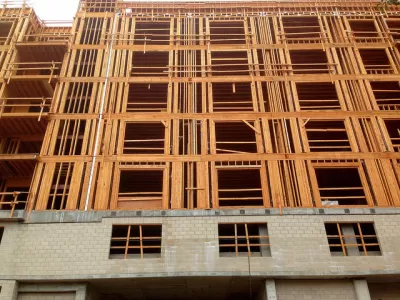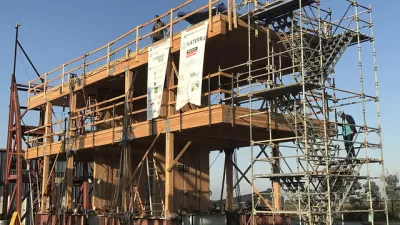A new kind of building will soon rise in the United States: the wooden tower. Extensive testing by the US Department of Agriculture and the timber industry will soon make timber viable for high-rise tower construction.

Although tall wood buildings in countries like Norway and Austria have made headlines around the world, mass timber, as this type of construction is known, has yet to make significant inroads here. Wood dominates low-rise residential construction in the US, but is absent in buildings more than five stories tall.
Many designers, timber industry representatives, and government officials are pushing for that to change. Their motivations vary. Mass timber offers incredible aesthetic benefits and could create new jobs in rural areas. It also holds tremendous potential to mitigate climate change. Carbon-heavy steel and concrete production accounts for almost 5% of the world’s greenhouse gas emissions. Mass timber products require no fossil fuels to produce — trees grow with solar energy alone — and can be replenished through sustainable logging and tree farms. As an added bonus, it can sequester carbon held in trees, preventing it from seeping into the atmosphere when they decay.
In 2014, the United States Department of Agriculture and timber industry partners, enthusiastic about the combination of new jobs and reduced greenhouse gas emissions, launched the U.S. Tall Wood Building Prize Competition. The contest offered $3 million to teams of designers and developers who pledged to build a mass timber tower at least 80 feet high.
FULL STORY: Fire-safety testing paves the way for timber towers

Planetizen Federal Action Tracker
A weekly monitor of how Trump’s orders and actions are impacting planners and planning in America.

Maui's Vacation Rental Debate Turns Ugly
Verbal attacks, misinformation campaigns and fistfights plague a high-stakes debate to convert thousands of vacation rentals into long-term housing.

Restaurant Patios Were a Pandemic Win — Why Were They so Hard to Keep?
Social distancing requirements and changes in travel patterns prompted cities to pilot new uses for street and sidewalk space. Then it got complicated.

In California Battle of Housing vs. Environment, Housing Just Won
A new state law significantly limits the power of CEQA, an environmental review law that served as a powerful tool for blocking new development.

Boulder Eliminates Parking Minimums Citywide
Officials estimate the cost of building a single underground parking space at up to $100,000.

Orange County, Florida Adopts Largest US “Sprawl Repair” Code
The ‘Orange Code’ seeks to rectify decades of sprawl-inducing, car-oriented development.
Urban Design for Planners 1: Software Tools
This six-course series explores essential urban design concepts using open source software and equips planners with the tools they need to participate fully in the urban design process.
Planning for Universal Design
Learn the tools for implementing Universal Design in planning regulations.
Heyer Gruel & Associates PA
JM Goldson LLC
Custer County Colorado
City of Camden Redevelopment Agency
City of Astoria
Transportation Research & Education Center (TREC) at Portland State University
Jefferson Parish Government
Camden Redevelopment Agency
City of Claremont




























